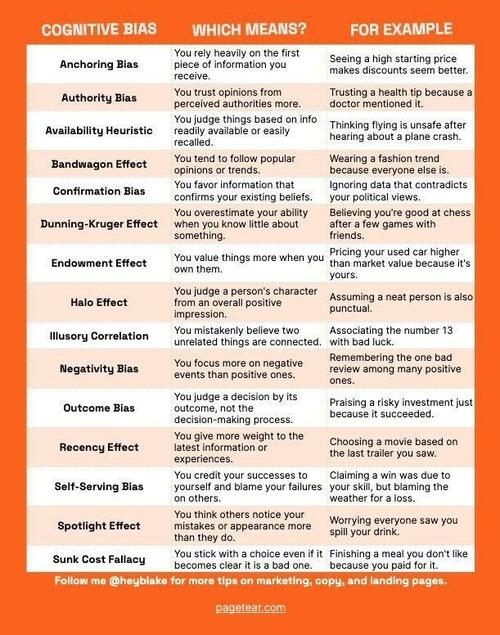
Authored by Michael Lebowitz via RealInvestmentAdvice.com,
Let’s play a hole of golf to appreciate how two distinct aspects of golf provide valuable lessons for investors.
You tee off with a driver on a 450-yard par four hole. Your drive is perfect. Not only does the ball land in the middle of the fairway, but you only have 200 yards remaining to the pin. Next, you pull out an iron, hit a beautiful shot, and the ball bounces onto the putting green. With only 40 feet between the ball and the pin and over 95% of the hole behind you, you think a birdie is possible, and in the worst case, you can get a par.
Your birdie putt misses by 10 feet. You come up just short on the next putt, and your confidence turns to angst. Finally, the third putt rattles into the cup, scoring a disappointing bogey.
Your long and straight 200-yard drive counts precisely as the 3-foot short putt you missed for par. Similarly, an investment idea backed by a well-thought-out macro thesis is only as good as adequately navigating the many short-term factors that can threaten investment performance.
Investing’s Long Game
The long game involves forming expectations of economic growth and how revenues and earnings for sectors and industries may change with the economy as it cycles through your big-picture thesis. More simply, the long game is investing based on a macroeconomic outlook.
Macroeconomic Analysis
Macroeconomic analysis studies the behavior and performance of a country’s economy and its interaction with the global economy. It focuses on broad aggregate variables, including existing economic trends, business cycles, productivity, demographics, geopolitics, governments/central banks, credit, and technological change.
An increasingly important part of macroeconomic analysis is assessing how fiscal and monetary policies might affect economic growth and price trends.
As we have recently witnessed, fiscal spending can have a massive impact on economic activity and inflation. However, as we may find out, it can also be a drag on economic activity in future years. Similarly, a central bank’s monetary policy, including how it manages interest rates and asset holdings, often dictates liquidity and financial conditions, significantly influencing asset markets and the economy.
International trade and finance, including geopolitics, can play noteworthy roles in macroeconomic analysis. This incorporates trade balances and exchange rates, which are predicated on interest rates and inflation. Other factors include competitiveness, foreign relationships, and foreign investor cash flows.
While longer-term views on the factors we note are critically important, we must also appreciate shorter periods in which our long-term thesis may seem out of favor. Importantly, we must assess whether aberrations to longer trends are short-term or new trends being established.
Similar to golf, an excellent long investing game is crucial to understanding the economic path that directly feeds corporate earnings and consumer and government spending behaviors. Think of the long game as a road map, and your goal is to get from point A to point B. Therefore, assessing the most efficient route is your paramount task.
Investing’s Short Game
As we now discuss, an investor’s short game is equally important. These are the inevitable traffic jams, accidents, and weather conditions that will force you to stray from the long game.
Investing’s short game includes market conditions, narratives, personal biases, behavioral traits, liquidity, and other factors that briefly influence asset prices away from longer-term trends.
Even if you have an outstanding macroeconomic outlook, ignoring the short game, like being a lousy putter in golf, virtually ensures a bogey or worse on your investment performance.
Biases and Behaviors
We have written numerous articles on our inherent biases and behavioral traits. For example, our latest on the topic, Behavioral Traits That Are Killing Your Portfolio Returns, reviews five traits that often hurt investors’ performance. We share a summary below, along with a bit of advice.
Confirmation Bias: favoring information that affirms your beliefs. Therefore, read investment advice that goes against your views and may be uncomfortable. It will strengthen your convictions or help you appreciate where your thesis may prove wrong.
Gamblers Fallacy: believing that future outcomes will follow prior outcomes. Today’s hot assets are often laggards tomorrow. While tracking and investing in today’s popular stocks is worthy, keep an open mind that some other stock or asset will likely be tomorrow’s winner.
Herd Bias: doing what everyone else is doing. The thought process is rooted in the belief that if “everyone else” is doing something, I must do it to be accepted. As we wrote in Behavioral Traits:
Investors generate the most profits in the long term by moving against the “herd.” Unfortunately, most individuals have difficulty knowing when to “bet” against the stampede.
Trading with the “herd” can be profitable at times. However, we must understand the inherent flaws in group logic and always appreciate the contrarian opinion.
The table below provides a few more examples.
Technical Analysis
Technical analysis is one of the best clubs in our short-game bag. While it can be inconsistent, as with every other forecasting model, it is the best tool for quantifying investors’ collective behaviors. Historical price and volume data provide a critical context for various price levels likely to motivate buyers and sellers.
Technical analysis helps detect trend changes. Like reading a putt, technical analysis can help us grasp the risks and rewards a market offers. Furthermore, it can provide price levels with which to buy or sell. In turn, limits allow us to separate our trading actions from our behavioral traits.
Liquidity Drivers/Fed
Financial market liquidity is impossible to quantify, even though investors throw the word around like it’s a known commodity. Liquidity refers to the funds available for investors to invest. When liquidity is plentiful, investors tend to take more risk. Conversely, when liquidity is lacking, investors are often risk-averse.
While liquidity is often considered part and parcel with actual investible dollars available, it’s more a function of investors’ cumulative actions. For instance, the Fed supplied the market with ample liquidity in late 2008, but a meaningful fear of significant bank failures crippled many investors. Sellers were plentiful, and buyers were hard to find. Liquidity was poor. The result was a sharp drawdown in equity prices with high volatility.
The Fed supplies monetary liquidity to the banking system through interest rate policy and its balance sheet. Furthermore, as their role seemingly becomes more dominant with time, their actions become more impactful to markets. Consequently, as we see today, the stock market rallies as prospects of the Fed providing more liquidity via lower interest rates.
Domestic and Global Events
War, weather events, terrorism, political instability, and other local or global events can move markets. Quite often, event-driven trends are short-lived. During event-related volatile periods, investors should try to remain cool and calm. It’s easy to sell into a fear-laced narrative. It’s much harder to buy in such an environment. To quote Warren Buffett:
Be fearful when others are greedy and be greedy only when others are fearful.
Summary
A well-thought-out long-game thesis can stay intact for long periods with slight adjustments when needed. Like a long and straight drive in golf, when your macroeconomic thesis proves correct, a good portion of your investing job is done.
But, like golf, letting your irrational behaviors control your investment acumen, not appreciating that markets are sometimes foolish, or misdiagnosing what the Fed is doing can devastate shorter- and longer-term results.
Do not forget the two-foot putt counts the same as a daunting drive off the tee box.
Authored by Michael Lebowitz via RealInvestmentAdvice.com,
Let’s play a hole of golf to appreciate how two distinct aspects of golf provide valuable lessons for investors.
You tee off with a driver on a 450-yard par four hole. Your drive is perfect. Not only does the ball land in the middle of the fairway, but you only have 200 yards remaining to the pin. Next, you pull out an iron, hit a beautiful shot, and the ball bounces onto the putting green. With only 40 feet between the ball and the pin and over 95% of the hole behind you, you think a birdie is possible, and in the worst case, you can get a par.
Your birdie putt misses by 10 feet. You come up just short on the next putt, and your confidence turns to angst. Finally, the third putt rattles into the cup, scoring a disappointing bogey.
Your long and straight 200-yard drive counts precisely as the 3-foot short putt you missed for par. Similarly, an investment idea backed by a well-thought-out macro thesis is only as good as adequately navigating the many short-term factors that can threaten investment performance.
Investing’s Long Game
The long game involves forming expectations of economic growth and how revenues and earnings for sectors and industries may change with the economy as it cycles through your big-picture thesis. More simply, the long game is investing based on a macroeconomic outlook.
Macroeconomic Analysis
Macroeconomic analysis studies the behavior and performance of a country’s economy and its interaction with the global economy. It focuses on broad aggregate variables, including existing economic trends, business cycles, productivity, demographics, geopolitics, governments/central banks, credit, and technological change.
An increasingly important part of macroeconomic analysis is assessing how fiscal and monetary policies might affect economic growth and price trends.
As we have recently witnessed, fiscal spending can have a massive impact on economic activity and inflation. However, as we may find out, it can also be a drag on economic activity in future years. Similarly, a central bank’s monetary policy, including how it manages interest rates and asset holdings, often dictates liquidity and financial conditions, significantly influencing asset markets and the economy.
International trade and finance, including geopolitics, can play noteworthy roles in macroeconomic analysis. This incorporates trade balances and exchange rates, which are predicated on interest rates and inflation. Other factors include competitiveness, foreign relationships, and foreign investor cash flows.
While longer-term views on the factors we note are critically important, we must also appreciate shorter periods in which our long-term thesis may seem out of favor. Importantly, we must assess whether aberrations to longer trends are short-term or new trends being established.
Similar to golf, an excellent long investing game is crucial to understanding the economic path that directly feeds corporate earnings and consumer and government spending behaviors. Think of the long game as a road map, and your goal is to get from point A to point B. Therefore, assessing the most efficient route is your paramount task.
Investing’s Short Game
As we now discuss, an investor’s short game is equally important. These are the inevitable traffic jams, accidents, and weather conditions that will force you to stray from the long game.
Investing’s short game includes market conditions, narratives, personal biases, behavioral traits, liquidity, and other factors that briefly influence asset prices away from longer-term trends.
Even if you have an outstanding macroeconomic outlook, ignoring the short game, like being a lousy putter in golf, virtually ensures a bogey or worse on your investment performance.
Biases and Behaviors
We have written numerous articles on our inherent biases and behavioral traits. For example, our latest on the topic, Behavioral Traits That Are Killing Your Portfolio Returns, reviews five traits that often hurt investors’ performance. We share a summary below, along with a bit of advice.
Confirmation Bias: favoring information that affirms your beliefs. Therefore, read investment advice that goes against your views and may be uncomfortable. It will strengthen your convictions or help you appreciate where your thesis may prove wrong.
Gamblers Fallacy: believing that future outcomes will follow prior outcomes. Today’s hot assets are often laggards tomorrow. While tracking and investing in today’s popular stocks is worthy, keep an open mind that some other stock or asset will likely be tomorrow’s winner.
Herd Bias: doing what everyone else is doing. The thought process is rooted in the belief that if “everyone else” is doing something, I must do it to be accepted. As we wrote in Behavioral Traits:
Investors generate the most profits in the long term by moving against the “herd.” Unfortunately, most individuals have difficulty knowing when to “bet” against the stampede.
Trading with the “herd” can be profitable at times. However, we must understand the inherent flaws in group logic and always appreciate the contrarian opinion.
The table below provides a few more examples.
Technical Analysis
Technical analysis is one of the best clubs in our short-game bag. While it can be inconsistent, as with every other forecasting model, it is the best tool for quantifying investors’ collective behaviors. Historical price and volume data provide a critical context for various price levels likely to motivate buyers and sellers.
Technical analysis helps detect trend changes. Like reading a putt, technical analysis can help us grasp the risks and rewards a market offers. Furthermore, it can provide price levels with which to buy or sell. In turn, limits allow us to separate our trading actions from our behavioral traits.
Liquidity Drivers/Fed
Financial market liquidity is impossible to quantify, even though investors throw the word around like it’s a known commodity. Liquidity refers to the funds available for investors to invest. When liquidity is plentiful, investors tend to take more risk. Conversely, when liquidity is lacking, investors are often risk-averse.
While liquidity is often considered part and parcel with actual investible dollars available, it’s more a function of investors’ cumulative actions. For instance, the Fed supplied the market with ample liquidity in late 2008, but a meaningful fear of significant bank failures crippled many investors. Sellers were plentiful, and buyers were hard to find. Liquidity was poor. The result was a sharp drawdown in equity prices with high volatility.
The Fed supplies monetary liquidity to the banking system through interest rate policy and its balance sheet. Furthermore, as their role seemingly becomes more dominant with time, their actions become more impactful to markets. Consequently, as we see today, the stock market rallies as prospects of the Fed providing more liquidity via lower interest rates.
Domestic and Global Events
War, weather events, terrorism, political instability, and other local or global events can move markets. Quite often, event-driven trends are short-lived. During event-related volatile periods, investors should try to remain cool and calm. It’s easy to sell into a fear-laced narrative. It’s much harder to buy in such an environment. To quote Warren Buffett:
Be fearful when others are greedy and be greedy only when others are fearful.
Summary
A well-thought-out long-game thesis can stay intact for long periods with slight adjustments when needed. Like a long and straight drive in golf, when your macroeconomic thesis proves correct, a good portion of your investing job is done.
But, like golf, letting your irrational behaviors control your investment acumen, not appreciating that markets are sometimes foolish, or misdiagnosing what the Fed is doing can devastate shorter- and longer-term results.
Do not forget the two-foot putt counts the same as a daunting drive off the tee box.
Loading…






